by Briscoe White | Nov 3, 2011 | Miscellaneous |
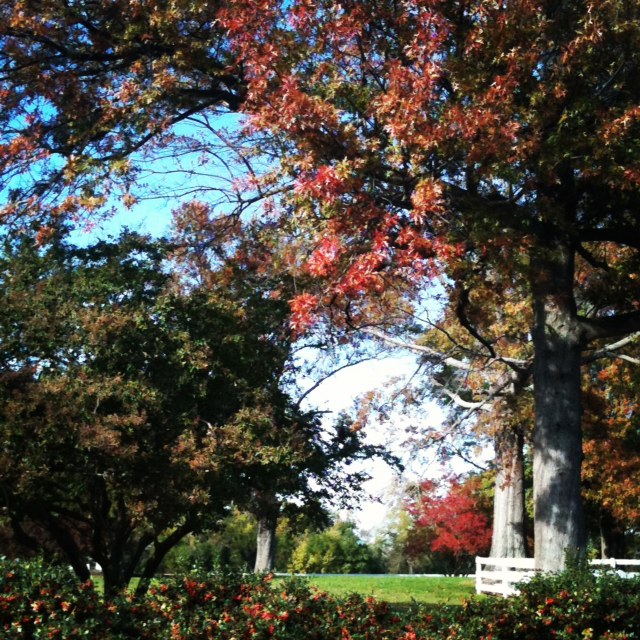
Fall has arrived at our farm! We’re just beginning November and soon the mad dash from holiday to holiday will ensue. We took this brief opportunity to get outside and enjoy the colors as the creep into the tree line.
Don’t forget to stock up on fresh culinary herbs for this holiday season, before it’s too late! We’ll continue our Fall Clearance Sale through Sunday, November 6th, where all of our 4″ herbs and flowers are only $3.00. After that, you’ll have to order early and wait til things thaw out in the spring!
In the meantime, here are a few reminders for Fall gardening:
* Don’t forget to mulch!
* This is the prime time to plant perennials and spring bulbs, so get digging!
* Time to bring in your tender perennials. Transplant into clean pots using new soil and don’t forget- they need at least 6 hours of direct sunlight to stay happy indoors.
* Some places have already seen snow this year (yikes!) so don’t forget to refill your bird feeders to make sure our feathered friends have plenty to eat.
* Deadhead perennials and remove any dead or diseased foliage.
* Start planning a winter or indoor garden.
by Briscoe White | Oct 31, 2011 | Miscellaneous |

It’s Halloween and on this macabre Monday we have a few harrowing tales about some of your most beloved plants! Many people are led to believe that the plants they’ve come to know in their gardens and greenhouses are innocent, unassuming herbs and flowers, but some of these commonplace plants have wicked reputations throughout history.
Many common herbs found in your own kitchen actually have various superstitions related to them. For instance, in the Middle Ages, people would sprinkle Rosemary under their pillows and mattresses to prevent nightmares and evil spirits from haunting their dreams.
You may be used to finding Fennel in your sausages, but people once placed Fennel seeds in the keyholes of their doors to keep ghosts from sneaking in. They also hung Fennel in their doorways during Midsummer Eve to evil spirits away from their homes, as this was the night they were thought to come back to earth. (For many cultures that still celebrate the Summer Solstice or Midsummer Eve, herbs are still very significant.)
Many people still use Cleansing Sticks to purify their new homes, apartments and offices, but did you know that this practice actually dates back to Native American prayer ceremonies? Drying White Sage (some people also use Garden Sage) and then rolling it and wrapping it tightly into a small, compact bundle, allows the sage to smolder instead of burn up in a flash. The bundle is then carried from room to room, allowing the smoke to waft throughout the dwelling to keep negative energy and evil spirits away.
Achillea and Rue were both sprinkled around windows and doorways to keep ghosts, witches and evil spirits from entering a home. Rue, also known in traditional herbalism as “Witchbane” was also carried in bundles in peoples’ pockets to ward off witches. Now, witches have magic on their side, and after making a book of shadows, you’d think they’d have documented all of their deepest darkest secrets to find a way to counteract this practice (in the safest way possible of course). Or maybe they didn’t. I don’t know enough about witchcraft to make an accurate judgment, but people seemed to believe this idea. It was also thought that both Achillea (Yarrow) and Rue would protect a person from hexes and the “evil eye”. Achillea was also hung over babies’ cribs to protect their souls from witches.
These are just a few of the historically “haunted” herbs that you can commonly find in your garden or pantry. Most medicinal herbs were used for protection from plagues, hexes and witches…what people didn’t realize was that in most cases, it was the antiseptic, anti bacterial or anti fungal properties of the plant that protected them from the supposed hauntings and conjured plagues.
For a great book on herbal folklore and poisonous plants from A-Z, check out Amy Stewart’s book Wicked Plants.
by Briscoe White | Oct 4, 2011 | Miscellaneous |
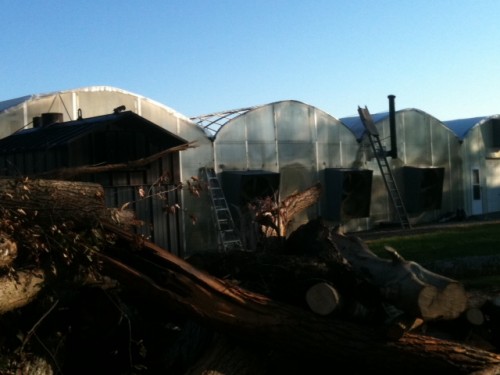
Wondering why we’re changing out the plastic roofs of our three main greenhouses? The benefits are actually twofold. By changing the roofs, with the help of a company like Cap City Restoration, we can help conserve energy. See the picture with the giant stack of wood below? We’ve chopped up some of the large trees that fell across our driveway during Hurricane Irene (We had about 30 trees across our driveway alone!) to use as fuel to heat our greenhouses this winter. To help our wood furnace heat the nursery more efficiently, we’re replacing the plastic that covers our greenhouses. In doing so, we’re adding new, sturdy plastic (similar to https://shrinkwrapcontainments.com/t-panda-premium.aspx) to prevent any holes from leaking heat out. That way it can stay nice and toasty warm inside without being too heavy. Additionally, we’re also creating an area of insulation to hold the heat in (when the summer months come around we will start thinking about getting some greenhouse fans to keep it cool and make sure it has proper airflow. This isn’t such a worry in the winter). We’ve used commercial blowers to fill the space between the inner and outer walls of the greenhouse with air. Once this space is filled it will create a pillow to help make a buffer against the cold and hold the heat in.
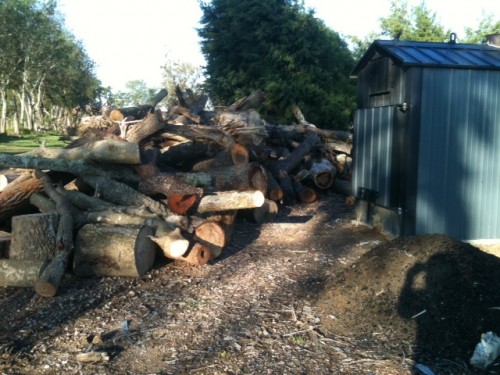
Heat is a huge concern for very obvious reasons. We winter over some of our plants, like Lemon Grass, which loves the heat. It thrives in zones 9-11 where it can get lots of sun. The new plastic and insulated walls will definitely help us to keep more cold-susceptible plants alive throughout the winter, so that we can offer you more mature plants, larger sizes and also have healthy specimen plants to make cuttings from in the Spring.

We’re also replacing the plastic on our roofs so that our plants can get more light. Especially after this past year’s weather (multiple snow storms, hurricanes, floods…even a freak earthquake!), the plastic had started to get pretty dingy. The yellowing of the plastic was filtering the sunlight and preventing more direct rays from getting in to the plants. After finishing one roof already, we can definitely see a huge difference in the amount of light inside the greenhouse. This will help prevent delays in crop availability, as we saw in a few cases this season due to Hurricane Irene and then Tropical Storm Lee. It kinda of gave a new meaning to the phrase, “when it rains, it pours” for us here in zone 7!

This is our newest member of The Growers Exchange, Brandon, helping us prep the roof for new plastic.
by Briscoe White | Sep 16, 2011 | Miscellaneous |
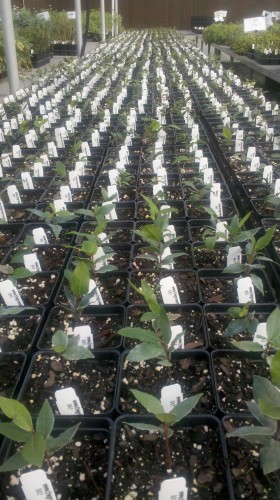
Bays are one of our favorite herbs to grow, as well as one of our most popular products for obvious reasons: It’s a terrific culinary herb that adds a great, savory flavor to your favorite dish, they can be pruned into beautiful topiaries, Bay oil is a natural insect repellent, and the plant can be used medicinally to cure a range of ailments. With all of these things to love about the noble Bay Tree, it’s still hard to be patient with its incredibly difficult germination process and slow growth. To fully appreciate how hard these wonderful plants are to cultivate and how special they are to own, we want to give you a glimpse at the early life cycle of the Bay.
Bays can be germinated from seed or propagated from cuttings. Each method has its own unique challenges, as it is often hard to find a specimen mature enough to take cuttings from and the seeds need meticulous care to germinate. Bay seeds must be obtained fresh and stratified before being sown. The process of stratification forces the plant embryo out of its natural dormancy phase, by simulating cold winter temperatures that would naturally allow the seed’s outer coat to soften and allow the embryo inside to break through. During this process the Bay seeds need to also be kept at a proper moisture level, as when left to dry out, they will not germinate. Once the stratification process is over and they are removed from refrigeration, the seeds need to continue to remain moist and must be sown immediately.
Bay seeds generally have a low germination rate due to their strict needs. Seeds with their pericarp removed (the tough outer seed layers, which are softened by stratification and moisture) only have about a 40% germination rate. In addition to being “needy seeds” and having a low chance of germination, it takes a very long time for the seeds to actually germinate, once planted. Taking roughly about fifty days to germinate, the seeds face a great chance of rotting before they are able to break through the soil. After germination, the plant has a tremendously slow growth rate and can take years to reach just a few feet in height. Grown in areas that mimic the Mediterranean climate that they are native to, like Southern California, the Bay can mature to a tree of twenty feet or more. In most areas though, Bays make a wonderful potted plant and may reach four or five feet high, but even this stature takes quite a while of growth.
Being a gardener means that you must be patient. It can be quite frustrating to put so much love and hard work into seeds that may not come to fruition, but when they do, it is a miraculous joy and triumph over mother nature. We hope that understanding the trials that a seed has to grow through just to get established and large enough to ship to your door, may help us all have patience with a plant like Bay. But believe us, they are more than well worth the wait!
by Briscoe White | Aug 25, 2011 | Miscellaneous |
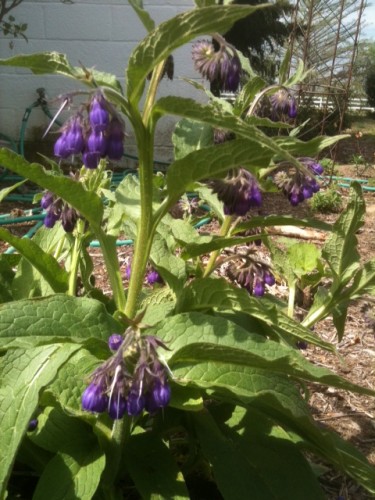
- This was the mother plant that we harvested the seeds from!
About mid June, we were faced with a comfrey seed crisis. There are only a few reliable sources for all but the most common herbs. No one had any and we had a deadline; if we were to have comfrey plants for fall– we must sow seeds now!
With nowhere else to look, we turned to our own garden. Just last year we had planted several comfrey plants in the garden surrounding the office. Seek and you will find! There on spent flowers stalks were the seeds we needed. So we sowed seed we collected and the young comfrey plants pictured here, are second generation Growers Exchange. These plants will establish this fall and return in spring as full grown plants, expect blue flowers in early summer.
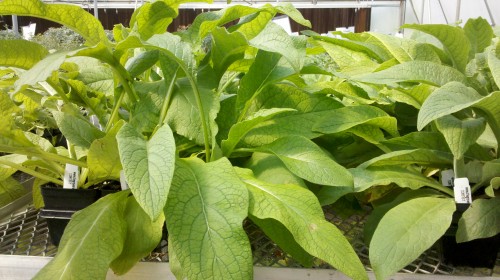
Our NEW Fall comfrey plants, grown from seeds harvested here at our farm!
The photo pictured above is a shot of our new comfrey plants! From the seeds that we harvested in our own gardens here on the farm, these plants have grown to be huge and healthy! We’re just about ready to ship them from our garden to yours, so get your orders in today to have first choice of these terrific herbs!
How can comfrey benefit your other plants? Read our previous blog about comfrey’s amazing ability to activate your compost and fertilize your garden! Looking for tips on how to grow the best comfrey plants? Check out Briscoe’s Tips to get the “dirt” on growing great plants!









